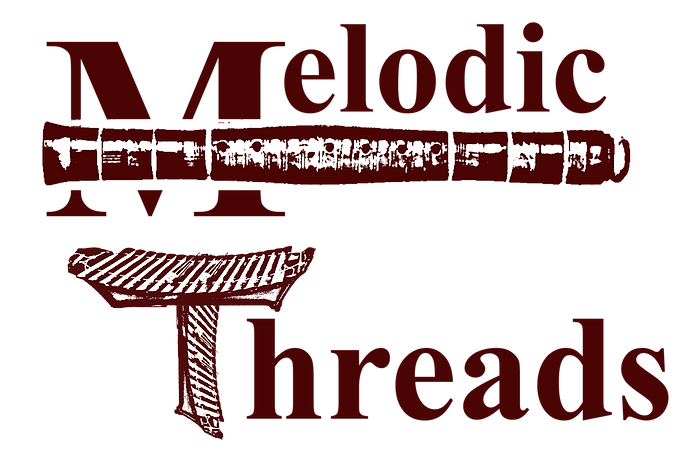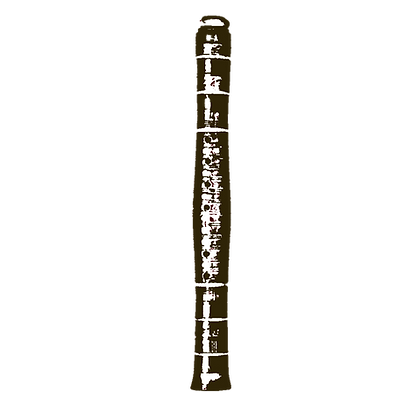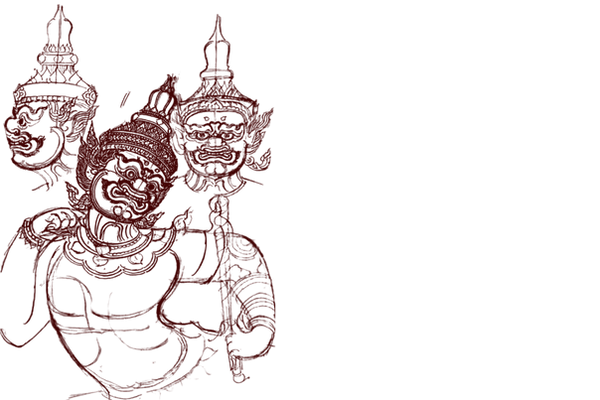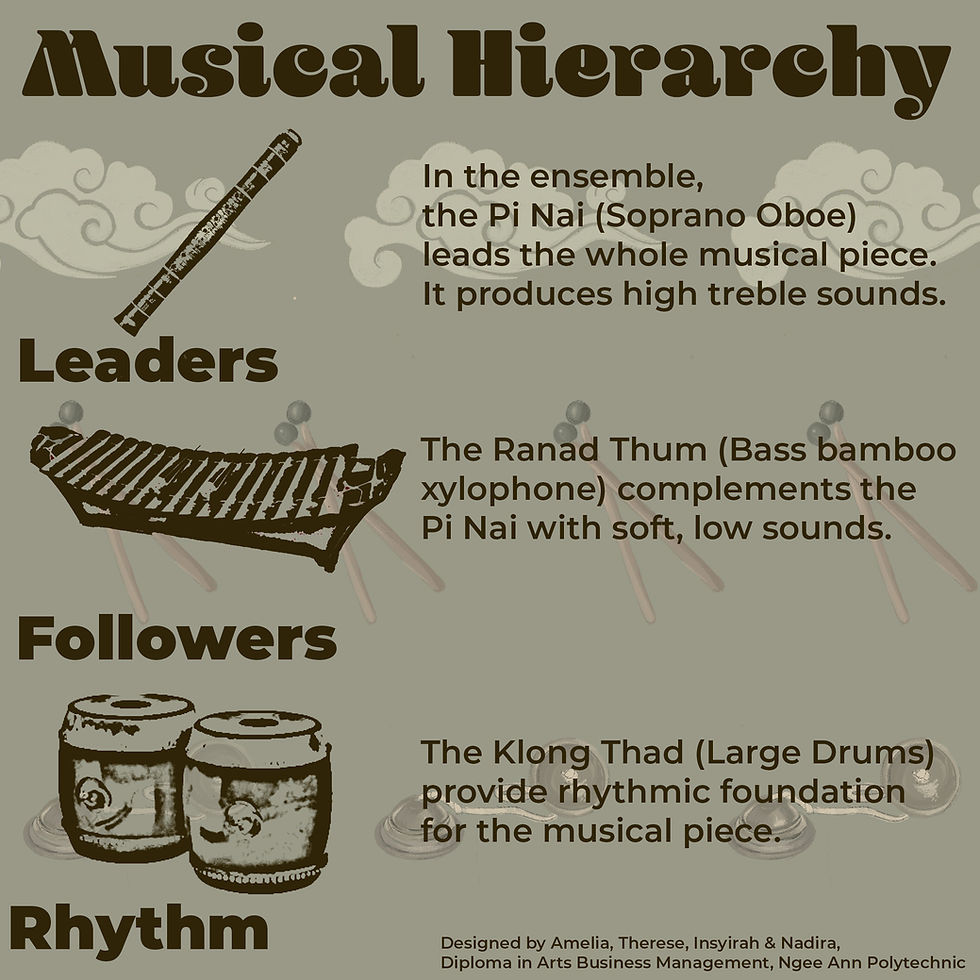Khon

In Thai Classical Music
There are three ensembles: (Sowat, 2018)
-
Wong Piphat (ปี่พาทย์)
-
Wong Khrueang Sai (วงเครื่องสาย)
-
Wong Mahoree (วงมโหรี)
Wong Piphat would be the ensemble to accompany Khon. (Kochetkova, 2023)
In all three ensembles, the instruments used can be classified into four musical groups;
-
khruang dit (เครื%องดีด) — plucked/ string
-
khruang si (เครื%องสี) — bowed
-
khruang ti (เครื%องตี) — percussion (melodic/ rhythmic)
-
khruang pao (เครื%องเป่า) — woodwind
The word khruang (เครื%อ) translates into instrument.
The instruments can be further categorised into 2 groups, depending on their tone and the role they play in the dance — Leader (khruang nam (เครื%องนำ)) and follower (khruang tam (เครื%องนำ)) instruments.
Leader instruments would have loud, high treble sounds while followers would have soft, low sounds.
Other instruments that provide a rhythmic pattern and provide the foundation for the music would not be considered as a leader or follower instrument.
These are the instruments used by the Piphat Ensemble to accompany Khon: (Thailand Foundation, n.d.)
-
Pi Nai (Soprano oboe)
-
Ranad Ek (Alto bamboo xylophone)
-
Ranad thum (Bass bamboo xylophone)
-
Khong wong lek (Small gongs in a horizontal circular frame)
-
Klong thad (Large drums)
-
Ta-pone (Two-faced tuned drums)
-
Krap (Wooden clappers)
-
Ching (Small cymbals)
In terms of instruments used,
the leader instruments would be the soprano oboe and the alto bamboo xylophone.
Follower instruments would include the bass bamboo xylophone, the small gong in a horizontal frame and the large gong in a horizontal frame.


Classical Thai Music used different key and pitch arrangements that involves the division of the octave into seven equidistant pitches.
The Piphat ensemble uses thang nai (ทางใน) , a group of notes that make up the music performed.
Thang (ทาง) has three different meanings.
-
A unique style of musical performance created by a particular master
-
The idiomatic variation of a particular music instrument developed from the basic melody. (a music piece whose meaning cannot be inferred from the meanings of the words/ notes that comprise it)
-
The different keys used in Thai music.
However in most cases, thang refers to the third meaning.
There are seven types of thang within Thai Music.
-
thang phiang o lang (ทางเพียงออล่าง)
-
thang nai (ทางใน) — Used in Khon
-
thang klang (ทางกลาง)
-
thang phiang o bon (ทางเพียงออบน)
-
thang nok (ทางนอก หรือทางกรวด)
-
thang klang hap (ทางกลางแหบ)
-
thang chawa (ทางชวา)
The names of all the thang come from the certain types of woodwind instruments used within particular ensembles as the leading instrument.
Thang Nai is used in the Piphat ensemble to accompany Khon and derives from the use of the Leader instrument, Pi Nai (Soprano oboe).The Piphat ensemble is particularly used for accompanying khon performance. The prominent features are the use of a hard pair of mallets for melodic percussions such as the alto bamboo xylophone, and the use of the soprano oboe).
Woodwind instruments play a key role in signifying the key scenarios in the performance and in determining the group of pitches employed in the different key arrangement.
The use of ‘basic melody’ used by the Pi Phat ensemble to accompany Khon:
Thamnonglak (ทำนองหลัก) would translate to basic melody.
The basic melody is the backbone of the whole musical piece and is made specific by one instrument. The other instruments used in the piece will have slight variance so that the music creates depth with their own version of playing. In other words, the improvised pieces from the other instruments embellish the instrument that provides the basic melody.
Despite all musicians needing to memorise the basic melody in the piece, it is only played by one instrument. In the case of Khon and the Piphat ensemble, the basic melody is played by the Khong Wong Yai (large circular gong).
Rhythmic structure and drum pattern application:
-
Changwa (จังหวะ) — rhythm
There are 4 types of rhythmic patterns.
-
Changwa thuapai (จังหวะทั(วไป) — formation of regular pulses taking place by weak and strong beats in music.
Thuapai (ทั#วไป) — means general
-
Changwa ching (จังหวะฉิ)ง) — rhythmic pattern provided by ching (a pair of small cup cymbals)
-
Changwa nathap (จังหวะหน้าทับ) indicates the rhythm formed by the drum pattern of the piece
-
Nathap (หน้าทับ) — duty of the drum
There are 3 duties of the drum
-
Nathap prop kai (หน้าทับปรบไก่) — regular and predictable drum pattern
-
Nathap song mai (หน้าทับสองไม้) — irregular, flexible and unpredictable drum patterns
-
nathap phiset (หน้าทับพิเศษ) — is a special drum pattern
-
Nathap aligns with Changwa. One unit of Nathap in a piece is equivalent to one unit of Changwa
-
Arta (อัตรา) — musical metre
With reference to Britannica (n.d), a musical metre refers to “rhythmic pattern constituted by the grouping of basic temporal units, called beats, into regular measures, or bars; in Western notation, each measure is set off from those adjoining it by bar lines.”
-
phleng naphat (เพลงหน้าพาทย์)
-
phleng ruang (เพลงเรื' อง)
-
phleng mahori (เพลงมโหรี )
The word phleng means ‘piece’ and can be either vocal or non-vocal music. Phleng naphat is used in Khon by the Piphat ensemble.
The 3 Categories of Thai Classical Music Pieces
Naphat is the piece to accompany or represent an action and is used in ritual repertoire like Khon. There are 3 levels of Naphat pieces.
-
Naphat chanton (primary level)
-
Naphat changklang (middle level)
-
Naphat chansung (high level)
During a Khon performance, the music played starts from the primary level and progresses to the highest level.
Songs used in performances known as Naphat: (Thailand Foundation, n.d.)
Different melodies explore different emotions of the characters and are used only in specific settings.
Paya Duen (The Walking Lord) – used when a high-ranking character like Phra Nam is in motion is a secondary level naphat.
Krao Nok (The Outer Krao) – used when monkeys are marching, is a primary level naphat.
Naphat in theatre is used to accompany actions like walking, fighting, crying, etc.
Only high level naphat is used when there is a God in play.
Music is used in Khon to create “mood or atmosphere for the dance that will color how the audience sees and experiences it. The rhythm, or pattern of beats in the music, can influence the speed and phrasing of the movement.” (Kennedy Center, n.d.)
In essence, the Pi Phat ensemble, plays a vital role in accompanying Khon. The ensemble's instruments, categorized into plucked/string, bowed, percussion, and woodwind groups, are designated as leaders or followers based on their tones and roles. Thang Nai, a specific style within Thai music, is crucial in Pi Phat, with Thamnonglak serving as the foundational melody played by instruments. The rhythmic intricacies, guided by Changwa patterns and Nathap drum duties, further contribute to the musical richness. Thai classical music, categorized into phleng naphat, phleng ruang, and phleng mahori, enhances the theatrical experience in Khon, influencing the mood, speed, and phrasing of movements to create a captivating and culturally significant performance.

References
Britannica. (n.d). Definition of metre. https://www.britannica.com/art/metre-music.
Bodensteiner, K. (2023, February 21). Music as Dance's Muse. The Kennedy Center. https://www.kennedy-center.org/education/resources-for-educators/classroom-resources/media-and-interactives/media/dance/music-as-dances-muse/#:~:text=The%20musical%20backdrop%20creates%20a,and%20phrasing%20of%20the%20movement.
Kochetkova, M. (2023, April 23). Khon - The Art of Thai Dance. Daily Art Magazine. https://www.dailyartmagazine.com/thai-dance/
Sowat, S. (2018, September). Thai Classical Music for the Phrommas Episode in Khon Performance. University of York Music. chrome-extension://efaidnbmnnnibpcajpcglclefindmkaj/https://etheses.whiterose.ac.uk/23075/1/Suchada%20Sowat-Thai%20Classical%20Music%20for%20the%20Phrommas%20Episode%20in%20Khon%20Performance.pdf
Thailand Foundation. (n.d). Music for the Soul: Wong Piphat, the Thai Classical Orchestra. https://www.thailandfoundation.or.th/culture_heritage/thai-classical-orchestra/
Thailand Foundation. (n.d). Khon: The Crown Jewel of Thai Performance Arts. https://www.thailandfoundation.or.th/culture_heritage/khon-the-crown-jewel-of-thai-performance-arts/#:~:text=Khon%20music%20is%20played%20by,klong%20thad%20(large%20drums)%2C